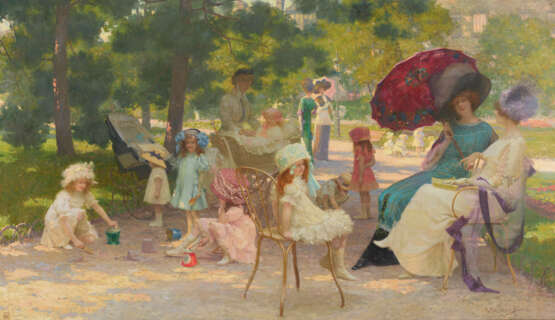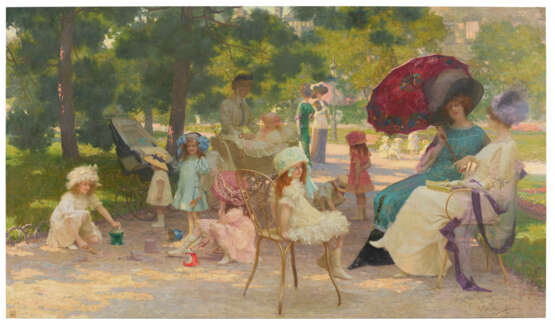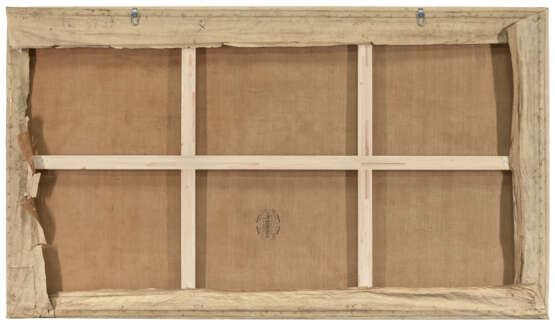RENÉ ROUSSEAU-DECELLE (LA ROCHE-SUR-YON 1881-1964 PRÉFAILLES )
11.06.2025 00:00UTC +00:00
Classic
Prix de départ
80000EUR € 80 000
Pour enchérir, allez sur le site
CHRISTIE'S| Auctioneer | CHRISTIE'S |
|---|---|
| Lieu de l'événement | Royaume-Uni, London |
| Commission | see on Website% |
ID 1437164
Lot 42 | RENÉ ROUSSEAU-DECELLE (LA ROCHE-SUR-YON 1881-1964 PRÉFAILLES )
Valeur estimée
€ 80 000 – 120 000
Au parc Monceau
signé et daté 'R. Rousseau-Decelle. / 1911' (en bas, à droite)
porte une étiquette imprimée '131' (en bas, à gauche)
huile sur toile, sur sa toile d'origine, sans cadre
146 x 253,5 cm (57 ½ x 99 13/16 in.)
Provenance
Collection de l'artiste ;
Puis par descendance dans la famille.
Literature
Fontenac, 'La Vendée au Salon de 1911', Revue du Bas-Poitou, 1911, 24e année, 2e livraison, p. 192.
L. Tider-Toutant, 'Le peintre Rousseau-Decelle', Le Pays d'Ouest, 10 février 1913, 3e année, 3, p. 70.
J. Perocheau, 'Rousseau-Decelle, un peintre vendéen à Paris', in A. Dary et al, René Rousseau-Decelle, [cat. exp.], La Roche-sur-Yon, 1988, p. 8.
Exhibited
Paris, Grand Palais des Champs-Elysées, Salon des artistes français, 1911, n°1632.
Further details
RENÉ ROUSSEAU-DECELLE (1881-1964), AU PARC MONCEAU, OIL ON CANVAS, UNLINED, SIGNED AND DATED (LOWER RIGHT), UNFRAMED
This painting and the following lot, Une répétition générale à Maisons-Laffitte chez le comte Robert de Clermont-Tonnerre, come directly from the estate of the artist, René Rousseau-Decelle (1881-1964). Rediscovered in 2024 in the painter's home and studio near La Rochelle, these two paintings had not been shown to the public since they were exhibited at the 1911 and 1912 Salons more than a century ago.
René Rousseau-Decelle was a refined observer of the late nineteenth and early twentieth centuries. His detailed paintings, with their documentary qualities, truly illustrated the ‘physiognomy of an era’, in the words of the critic Louis Tidier-Toutant (1861-1939), the painter's first biographer. Born in La Rochelle, the painter moved to Paris on the death of his father to attend the Lycée Henri IV, where he won first place in drawing. Though originally destined to study science, he turned to art, joining the famous Académie Julian in 1898, first as a pupil of Bouguereau (1825-1909), then of Luc-Olivier Merson (1846-1920). The crisp style of the two painters did leave a mark on the young artist, who shares with them a taste for bright planes of colour and neat outline. However, his undiluted tones and the sharp reflections on fabrics betray his modernity, reminding the viewer that he was both very much a man of the 20th century, and of the hedonistic fin de siècle.
Rousseau-Decelle was one of the best documenters of this period, retrospectively described as belle ‘beautiful’ in comparison with the brutal violence and severe disillusionment of the war years. In 1907, his talent as an observer won him a commission for a painting of a session of the National Assembly (inv. FNAC 2250), still on show at the Palais Bourbon. His talent for producing chiselled portraits, identifiable at a glance in large compositions, made him ideally suited to this panorama of deputies. Today's viewer can still easily make out Jaurès (1859-1914) at the rostrum of this assembly of politicians, but for the contemporary viewer dozens of these figures would have been immediately recogniseable.
Following the success of this work, Rousseau-Decelle executed more of these large-scale frescoes of everyday life, producing several in the years that followed. The remarkable composition Le pesage de Longchamp (sale, Christie's, New York, 23 May 2017, lot 27) presented at the Salon in 1910 depicted the distinguished world of horse racing. The previous year, he had exhibited another popular pastime, Le Palais des glaces (sale, Christie's, New York, 23 May 2017, lot 31) revealing the original state of one of the first artificial ice rinks to open in Paris!
The present composition depicts a Parc Monceau that is virtually unchanged to this day. Designed by Carmontelle (1717-1806) in the eighteenth century as a vast Anglo-Chinese garden populated by follies, the park had been tamed by 1912 by the sandy paths and low screen borders, visible here behind the children. The grand mansions surrounding the square, built by prestigious families (Rothschild, Camondo, Cernuschi), had already considerably reduced its space, so it is only really the dress of the people that separates the scene from one of today. As Marcel Proust (1871-1922) so aptly recounted in La Recherche, this was a place where society from the 8th arrondissement frequently gathered. The narrator often evoked the park and the pre-war women who lived nearby, wearing improbable hats that were often 'covered with an aviary or a garden'. Although the identities of the models in the painting have been lost, a photograph discovered in the painter's archives reveals a child in a sailor suit and a young woman (Fig. 1), possibly relatives of the artist, who may have slipped into the work.
| Technique appliquée: | Huile sur toile |
|---|---|
| Style artistique: | Vieux Maître |
| Genre: | Art de genre, Portrait |
| Lieu d'origine: | Europe de l'Ouest, France, Europe |
| Catégorie maison de vente aux enchères: | Peintures, Aquarelles, Dessins, Peintures |
| Technique appliquée: | Huile sur toile |
|---|---|
| Style artistique: | Vieux Maître |
| Genre: | Art de genre, Portrait |
| Lieu d'origine: | Europe de l'Ouest, France, Europe |
| Catégorie maison de vente aux enchères: | Peintures, Aquarelles, Dessins, Peintures |
| Adresse de l'enchère |
CHRISTIE'S 8 King Street, St. James's SW1Y 6QT London Royaume-Uni | |
|---|---|---|
| Aperçu |
| |
| Téléphone | +44 (0)20 7839 9060 | |
| Commission | see on Website | |
| Conditions d'utilisation | Conditions d'utilisation |




